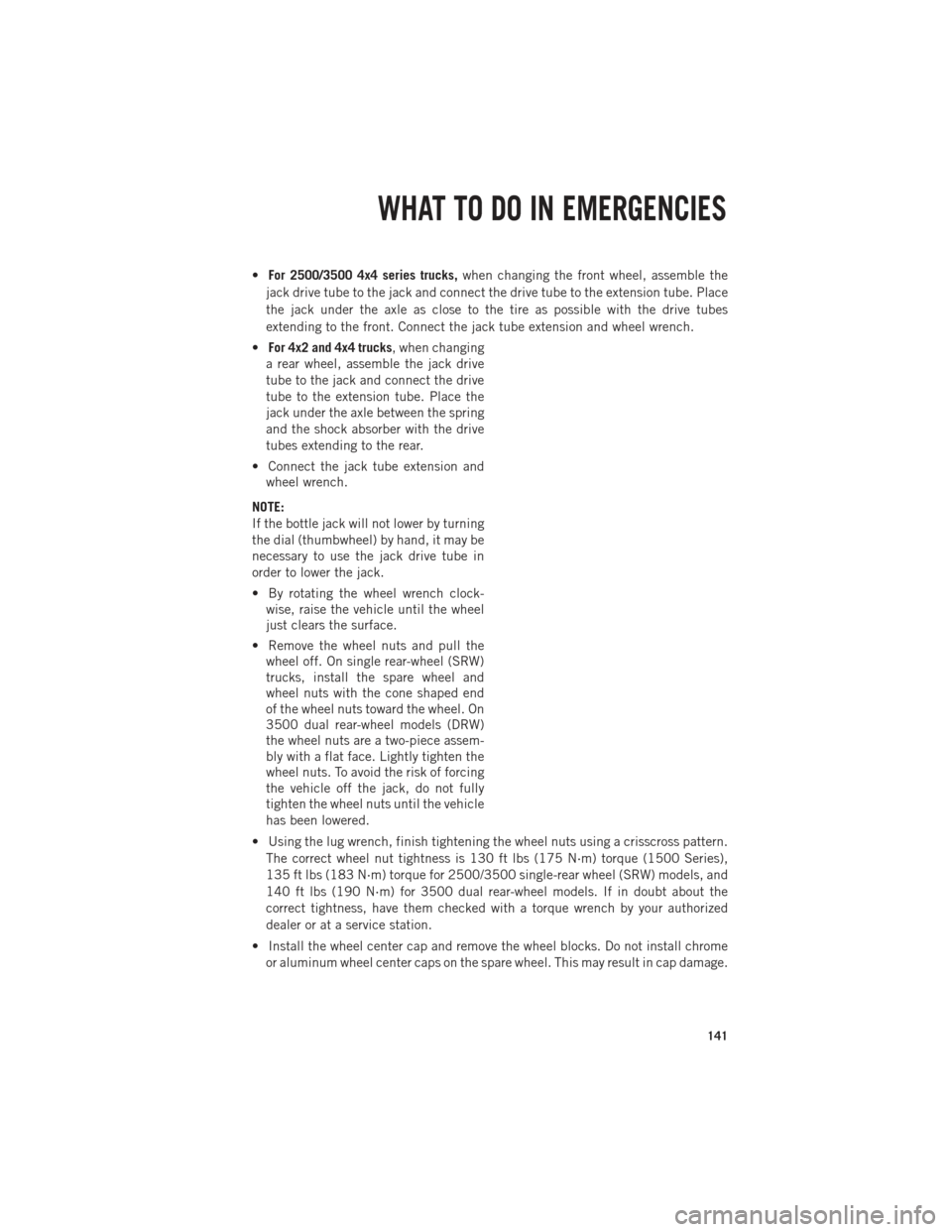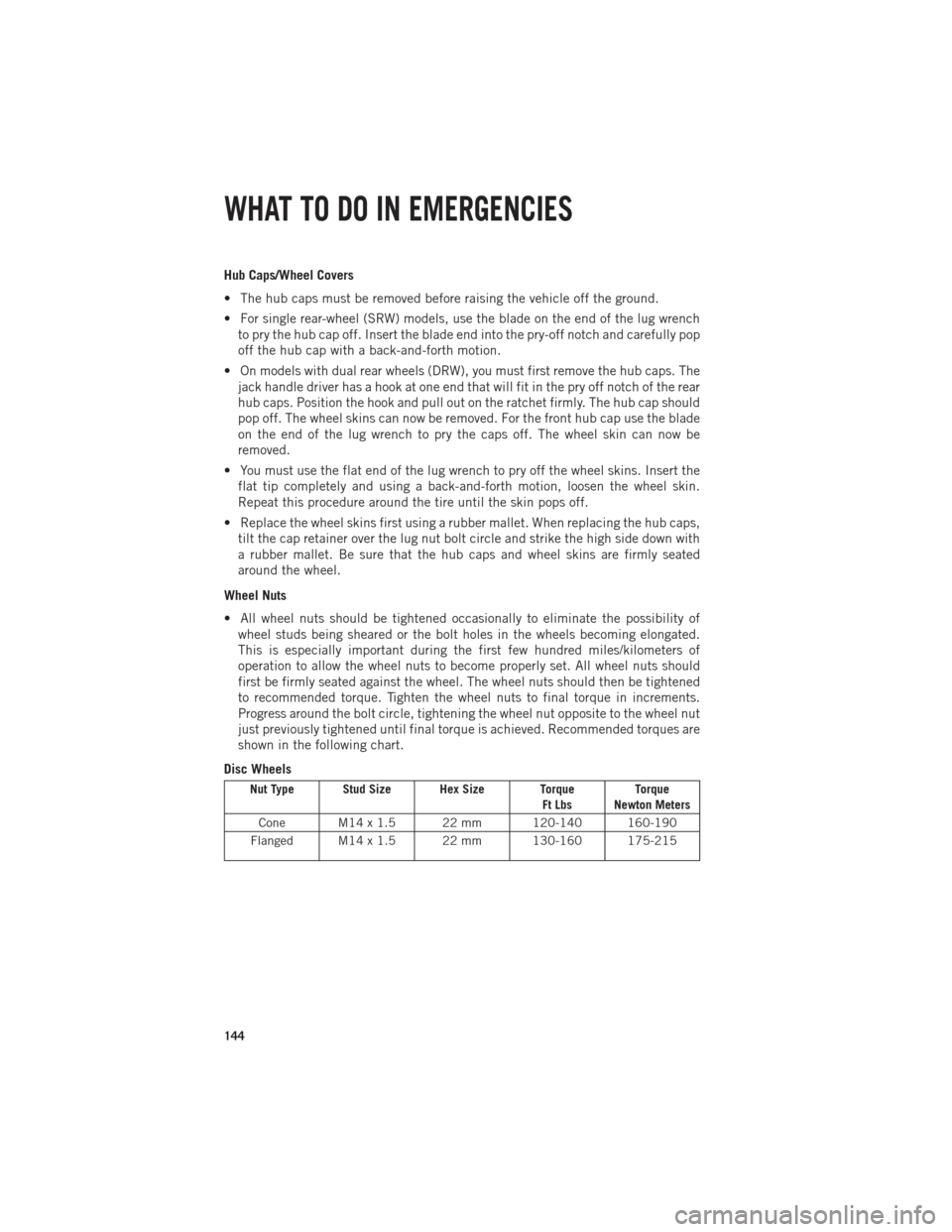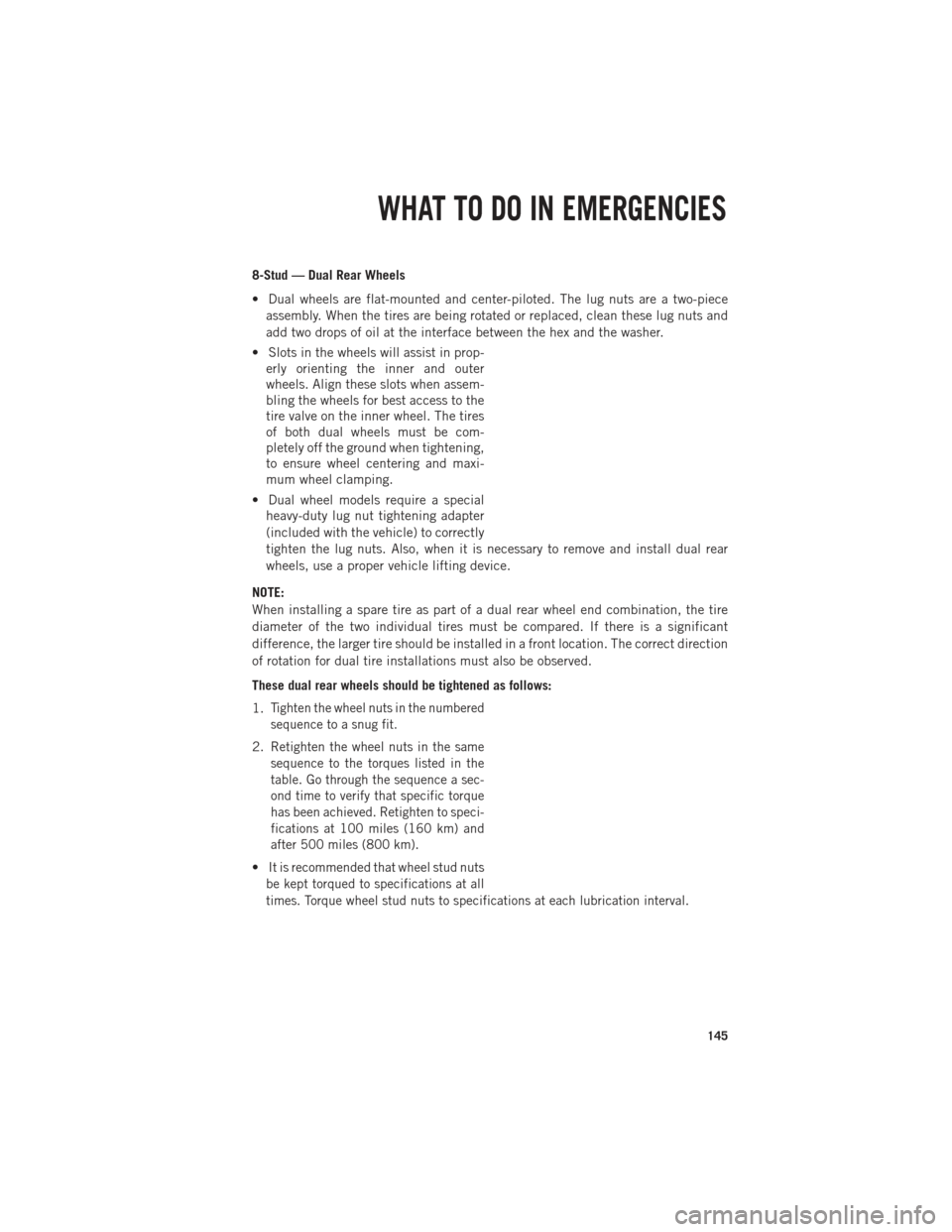torque Ram 1500 2013 Get to Know Guide
[x] Cancel search | Manufacturer: RAM, Model Year: 2013, Model line: 1500, Model: Ram 1500 2013Pages: 196, PDF Size: 9.66 MB
Page 130 of 196

System Overview
• This vehicle is equipped with a Diesel Exhaust Fluid (DEF) injection system anda Selective Catalytic Reduction (SCR) catalyst to meet the emission requirements.
• The DEF injection system consists of the following components: • DEF tank
• DEF pump
• DEF injector
• Electronically-heated DEF lines
• DEF control module
• NOx sensors
• NH3 sensor
• Temperature sensors
• SCR catalyst
• The DEF injection system and SCR catalyst enable the achievement of diesel emissions requirements; while maintaining outstanding fuel economy, drivability,
torque and power ratings.
NOTE:
• Your vehicle is equipped with a DEF injection system. You may occasionally hear an audible clicking noise. This is normal operation.
• The DEF pump will run for a period of time after engine shutdown to purge the DEF system. This is normal operation.
Diesel Exhaust Fluid Storage
• Diesel Exhaust Fluid (DEF) is considered a very stable product with a long shelf life. If DEF is kept in temperatures between 10° to 90°F (-12° to 32°C), it will last
a minimum of one year.
• DEF is subject to freezing at the lowest temperatures. For example, DEF may freeze at temperatures at or below 12° F (-11° C). The system has been designed
to operate in this environment.
NOTE:
When working with DEF, it is important to know that:
• Any containers or parts that come into contact with DEF must be DEF compatible (plastic or stainless steel). Copper, brass, aluminum, iron or non-stainless steel
should be avoided as they are subject to corrosion by DEF.
• If DEF is spilled, it should be wiped up completely.
DIESEL
128
Page 143 of 196

•For 2500/3500 4x4 series trucks, when changing the front wheel, assemble the
jack drive tube to the jack and connect the drive tube to the extension tube. Place
the jack under the axle as close to the tire as possible with the drive tubes
extending to the front. Connect the jack tube extension and wheel wrench.
• For 4x2 and 4x4 trucks, when changing
a rear wheel, assemble the jack drive
tube to the jack and connect the drive
tube to the extension tube. Place the
jack under the axle between the spring
and the shock absorber with the drive
tubes extending to the rear.
• Connect the jack tube extension and wheel wrench.
NOTE:
If the bottle jack will not lower by turning
the dial (thumbwheel) by hand, it may be
necessary to use the jack drive tube in
order to lower the jack.
• By rotating the wheel wrench clock- wise, raise the vehicle until the wheel
just clears the surface.
• Remove the wheel nuts and pull the wheel off. On single rear-wheel (SRW)
trucks, install the spare wheel and
wheel nuts with the cone shaped end
of the wheel nuts toward the wheel. On
3500 dual rear-wheel models (DRW)
the wheel nuts are a two-piece assem-
bly with a flat face. Lightly tighten the
wheel nuts. To avoid the risk of forcing
the vehicle off the jack, do not fully
tighten the wheel nuts until the vehicle
has been lowered.
• Using the lug wrench, finish tightening the wheel nuts using a crisscross pattern. The correct wheel nut tightness is 130 ft lbs (175 N·m) torque (1500 Series),
135 ft lbs (183 N·m) torque for 2500/3500 single-rear wheel (SRW) models, and
140 ft lbs (190 N·m) for 3500 dual rear-wheel models. If in doubt about the
correct tightness, have them checked with a torque wrench by your authorized
dealer or at a service station.
• Install the wheel center cap and remove the wheel blocks. Do not install chrome or aluminum wheel center caps on the spare wheel. This may result in cap damage.
WHAT TO DO IN EMERGENCIES
141
Page 146 of 196

Hub Caps/Wheel Covers
• The hub caps must be removed before raising the vehicle off the ground.
• For single rear-wheel (SRW) models, use the blade on the end of the lug wrenchto pry the hub cap off. Insert the blade end into the pry-off notch and carefully pop
off the hub cap with a back-and-forth motion.
• On models with dual rear wheels (DRW), you must first remove the hub caps. The jack handle driver has a hook at one end that will fit in the pry off notch of the rear
hub caps. Position the hook and pull out on the ratchet firmly. The hub cap should
pop off. The wheel skins can now be removed. For the front hub cap use the blade
on the end of the lug wrench to pry the caps off. The wheel skin can now be
removed.
• You must use the flat end of the lug wrench to pry off the wheel skins. Insert the flat tip completely and using a back-and-forth motion, loosen the wheel skin.
Repeat this procedure around the tire until the skin pops off.
• Replace the wheel skins first using a rubber mallet. When replacing the hub caps, tilt the cap retainer over the lug nut bolt circle and strike the high side down with
a rubber mallet. Be sure that the hub caps and wheel skins are firmly seated
around the wheel.
Wheel Nuts
• All wheel nuts should be tightened occasionally to eliminate the possibility of wheel studs being sheared or the bolt holes in the wheels becoming elongated.
This is especially important during the first few hundred miles/kilometers of
operation to allow the wheel nuts to become properly set. All wheel nuts should
first be firmly seated against the wheel. The wheel nuts should then be tightened
to recommended torque. Tighten the wheel nuts to final torque in increments.
Progress around the bolt circle, tightening the wheel nut opposite to the wheel nut
just previously tightened until final torque is achieved. Recommended torques are
shown in the following chart.
Disc Wheels
Nut Type Stud Size Hex Size Torque Ft LbsTorque
Newton Meters
Cone M14 x 1.5 22 mm 120-140 160-190
Flanged M14 x 1.5 22 mm 130-160 175-215
WHAT TO DO IN EMERGENCIES
144
Page 147 of 196

8-Stud — Dual Rear Wheels
• Dual wheels are flat-mounted and center-piloted. The lug nuts are a two-pieceassembly. When the tires are being rotated or replaced, clean these lug nuts and
add two drops of oil at the interface between the hex and the washer.
• Slots in the wheels will assist in prop- erly orienting the inner and outer
wheels. Align these slots when assem-
bling the wheels for best access to the
tire valve on the inner wheel. The tires
of both dual wheels must be com-
pletely off the ground when tightening,
to ensure wheel centering and maxi-
mum wheel clamping.
• Dual wheel models require a special heavy-duty lug nut tightening adapter
(included with the vehicle) to correctly
tighten the lug nuts. Also, when it is necessary to remove and install dual rear
wheels, use a proper vehicle lifting device.
NOTE:
When installing a spare tire as part of a dual rear wheel end combination, the tire
diameter of the two individual tires must be compared. If there is a significant
difference, the larger tire should be installed in a front location. The correct direction
of rotation for dual tire installations must also be observed.
These dual rear wheels should be tightened as follows:
1.
Tighten the wheel nuts in the numbered
sequence to a snug fit.
2.Retighten the wheel nuts in the same
sequence to the torques listed in the
table. Go through the sequence a sec-
ond time to verify that specific torque
has been achieved. Retighten to speci-
fications at 100 miles (160 km) and
after 500 miles (800 km).
•It is recommended that wheel stud nuts
be kept torqued to specifications at all
times. Torque wheel stud nuts to specifications at each lubrication interval.
WHAT TO DO IN EMERGENCIES
145
Page 191 of 196

SIRIUS Travel Link...........89
SparkPlugs..............162
Speed Control (Cruise Control) ....28
Starting Cold Weather ...........121
Remote ...............13
Starting Procedures (Diesel Engines) ..........120
SunRoof ................40
Tailgate ................108
Temperature Control, Automatic(ATC)...........36
Theft System Arming ..........13
Theft System Disarming ........13
Tires Air Pressure ...........182
Changing .............137
FlatChanging ..........137
Jacking ..............137
Pressure Monitor System
(TPMS) ...............38
Pressure Warning Light .....130
Tow/Haul................116
Tow Hooks, Emergency ........150
Towing Disabled Vehicle .........153
Recreational ...........118 Towing Vehicle Behind a
Motorhome .............118
Trailer Towing Trailer and Tongue Weight . . .114
Transfer Case Fluid ................162
Transmission Fluid ................162
WarningLight ..........133
TurnSignals...............26
Uconnect
®3.0.............54
Uconnect®5.0.............56
Uconnect®8.4A ............62
Uconnect®8.4AN ...........79
Ventilated Seats ............22
Washers, Windshield ..........26
Water in Fuel .............120
WheelandWheelTrimCare.....182
Wheel Cover ..............144
WheelNutTorque...........144
Wind Buffeting .............41
Windshield Washers ..........26
Windshield Wipers ...........26
INDEX
189